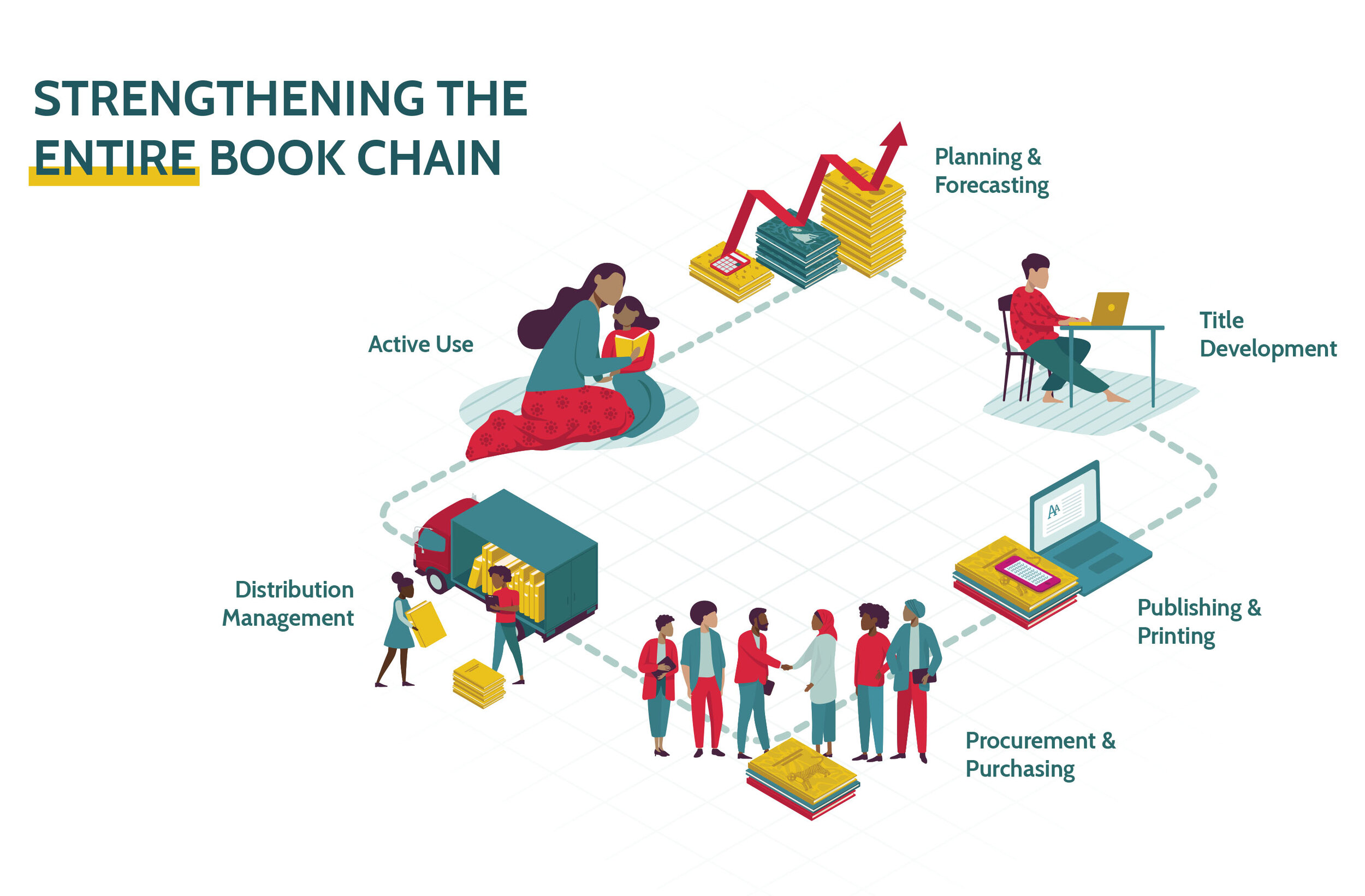the Book Chain
An effective supply of books requires high-quality title development in languages and formats children can use and understand, access to those titles by printers and publishers, and a functioning supply chain to deliver books to their potential readers.
PLANNING AND FORECASTING
Planning and forecasting is recurring/cyclical work carried out by governments and publishers to assess need and demand for books, and to arrange for the financial and material resources to meet that demand. In order to do this, ministries of education need timely information not only on enrollment, but on projected enrollment and realistic estimates of book wastage over time. Publishers must plan for, and be prepared to respond to, demand from ministries and schools, as well as parents who may purchase books for their children’s reading practice. For an MoE, the collection, management, analysis, and use of data on book needs/demand and provision is integral to education planning. For the publishers, it is market research. For both, accurate and timely data collection is of key importance for a functioning book supply chain.
Title Development
Title development refers to the creation of texts and books intended to support acquisition of reading skills in languages children use and understand. The process of title development begins once an author has been selected (or in some cases, a complete manuscript has been chosen for publication) and continues until the final PDFs of the book are sent to the printer. It is a process that calls on the skills of pedagogical experts, writers, editors, graphic designers, illustrators, proofreaders, page layout specialists, and others. The function of title development for Essential Reading Materials can be carried out by publishers, whether state or private, and as is often the case in developing countries, by donors and non-governmental organizations (NGOs) who step in to provide these materials where they do not exist.
Publishing and Printing
Publishing generally encompasses the contracting of authors, and all the steps of title development described in the previous section (writing, editing, illustrating, graphic design, and page makeup). It also includes the ownership, licensing, and marketing of intellectual property. In the case of a private sector publisher, publishing is a for-profit business. Where state publishing exists, the MoE staff generally creates the curriculum and accompanying textbooks.
Printing refers to the manufacturing process, whereby the final pdf is transformed into a printed, bound book by means of ink, paper and a printing press, and then binding equipment. Sometimes private publishers have their own printing press, but more often, they contract out the printing. In the case of a state publisher, books may be printed by a state printer, or tendered out to a private printer.
Procurement and Purchasing
Procurement and Purchasing is the acquisition of books and texts to support reading acquisition. In the education sector, the largest procurer of books is often the government, which will select vendors, establish payment terms, negotiate contracts for per unit and print run prices for reading materials, and pay vendors. Purchasing may also involve non-standard financing models, such as the use of Advanced Market Commitments or purchasing consortia. Individual teachers, families, and students are also book consumers and may purchase books depending on their ability to pay for them.
Distribution Management
Distribution management encompasses the organization, oversight, and activities involved in moving books from the point of origination to the point where learners access them, and includes packaging, inventory, warehousing, and logistics.
Even when challenges related to title development and procurement have been addressed, books may not make it to the classrooms and the children they are intended to benefit. This can happen for a myriad of reasons, including challenging conditions of climate and geography, inadequate transportation infrastructure, unrealistic distribution budgets and timelines, corruption in the supply chain, and more.
Active Use
Active use refers to the effective use of books by learners, their teachers, and children’s family members and caregivers. Children’s development of reading skills hinges on the effective use of books in classrooms and homes, and is directly affected by an adequate provision of essential and supplemental reading materials.
Factors that impact book use, both in and outside of school, are therefore essential considerations in analyzing the book chain. Evidence has shown that teachers and families often do not know of the importance of reading practice and how to support it effectively. Further, unstable book supplies and penalties for book damage can lead teachers to restrict access to books, and delays in distribution mean that teacher trainings occur without any of the materials teachers will use in the classroom.







